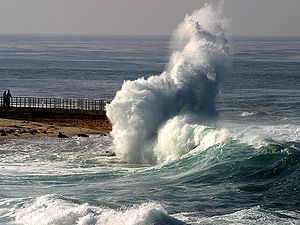Sea

A sea is a large body of saline water that may be connected with an ocean or may be a large saline lake that, like the Caspian Sea, lacks a natural outlet. Sometimes the terms sea and ocean are used synonymously.[1]
Frozen salt water is transformed into "sea ice"; this occurs below the freezing point of pure water—at about −1.8 °C (28.8 °F).[2]
History

Humans have navigated the seas since antiquity. The Ancient Egyptians and Phoenicians navigated the Mediterranean Sea and the Red Sea, while Hannu was the first sea explorer for whom substantial information exists in the modern era. Hannu sailed along the Red Sea, eventually reaching the Arabian Peninsula and the African Coast around 2750 BC.[3] In the 1st millennium BC, Phoenicians and Greeks established colonies throughout the Mediterranean, including outlets like the Black Sea. The seas along the eastern and southern Asian coast were used by the Arabs and Chinese for navigation, while the North Sea and the Baltic Sea were known to Europeans during Roman times. Other seas were not used for navigation in the ancient era, as they had yet to be discovered.
The White Sea was known to Novgorodians and used for navigation since not later that the 13th century.[4] Pomors, living at the White Sea coast, also sailed to Svalbard, but the Barents Sea got its name later, due to the 16th century Dutch expedition headed by Willem Barentsz. Other seas in Arctic Russia were also explored in connection with the search of the Northern Sea Route. In the first half of the 17th century the Kara Sea was already used on a regular basis for navigation between the city of Arkhangelsk and the mouth of the Ob River and upstream to the city of Mangazeya (Mangazeya Trade Route) and to the mouth of the Yenisei River (Yenisey Trade Route).[5] In 1648, Semyon Dezhnyov led an expedition down the Kolyma River, around the cape now known as Cape Dezhnev, and to the mouth of the Anadyr River.[6] By the end of the 17th century, the seas along what is now the Arctic and Pacific coasts of Russia were already discovered, although the systematic description and reliable mapping of the coast line only began in the 18th century, and the geographical locations of all islands were not established until the first half of the 20th century, [citation needed] when aviation was employed.
List of seas
| Template:Multicol |
|
| class="col-break " |
| class="col-break " |
|} |

|}
Others
| class="col-break " |
| class="col-break " |
| class="col-break " |
|}
| class="col-break " |
| class="col-break " |
| class="col-break " |

|}
| class="col-break " |
| class="col-break " |
| class="col-break " |
|}
| class="col-break " |
| class="col-break " |
| class="col-break " |
|}
- Arafura Sea
- Banda Sea
- Bering Sea
- Bismarck Sea
- Bohai Sea
- Bohol Sea (also known as the Mindanao Sea)
- Camotes Sea
- Celebes Sea
- Ceram Sea
| class="col-break " |
- Chilean Sea
- Sea of Chiloé
- Coral Sea
- East China Sea
- Flores Sea
- Gulf of Alaska
- Gulf of California (also known as the Sea of Cortéz)
- Gulf of Carpentaria
- Gulf of Thailand
| class="col-break " |
- Halmahera Sea
- Java Sea
- Koro Sea
- Mar de Grau
- Molucca Sea
- Philippine Sea
- Salish Sea
- Savu Sea
- Sea of Japan
- Sea of Okhotsk
| class="col-break " |
|}
Some large inland lakes, usually brackish, are called "seas". Template:Multicol
| class="col-break " |
| class="col-break " |
|}
See also
- Oceanography
- European Atlas of the Seas
- Inlet
- International Maritime Organization
- List of places on land with elevations below sea level
- Pole of inaccessibility: the locations farthest from any coastline
- Marine debris
- Sea level
- Sea level rise
- Sea salt
- Seven Seas
- Borders of the oceans
References
- ^ "Sea - Definition and More from the Free Merriam-Webster Dictionary". Merriam-webster.com. Retrieved 2012-03-13.
- ^ "Sea ice (ice formation)". Britannica Online Encyclopedia. 2012 [last update]. Retrieved 5 March 2012.
{{cite web}}: Check date values in:|year=(help) - ^ "The Ancient World - Egypt". marinersmuseum.org. Mariners' Museum. 2012 [last update]. Retrieved 5 March 2012.
{{cite web}}: Check date values in:|year=(help) - ^ "Зацепились за Моржовец" (in Russian). Русское географическое общество. 2012 [last update]. Retrieved 5 March 2012.
{{cite web}}: Check date values in:|year=(help) - ^ Урванцев, Н. Н. (1969). "История открытия и освоения медно-никелевых руд Сибирского Севера" (in Russian). Moscow: Недра. Retrieved 7 March 2012.
- ^ Howgego, Ray (2001 [last update]). "Discoverers Web: Dezhnev". win.tue.nl. Retrieved 7 March 2012.
{{cite web}}: Check date values in:|year=(help) - ^ a b c often treated as part of Mediterranean Sea
